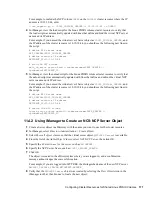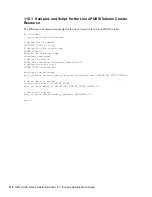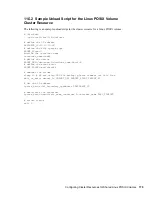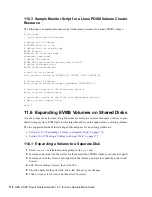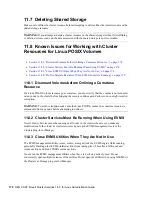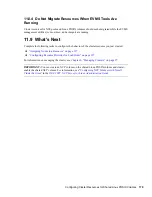
164
OES 2 SP2: Novell Cluster Services 1.8.7 for Linux Administration Guide
no
vd
ocx
(e
n)
7 Ja
nua
ry 201
0
11.3.3 Configuring a Load Script for a Linux POSIX Volume
Cluster Resource
The resource load script specifies the commands to start the resource (including mounting the file
system) on a server in the cluster. A load script is required for each Linux volume that you cluster-
enable.
EVMS containers are the unit of failover for Linux POSIX volumes. Because the EVMS container
is the unit of failover, all volumes in a container also fail over, but only the volumes that are
mounted through the cluster resource load script are automatically mounted on failover. Any
volumes in the container that are not mounted through the resource load script must be mounted
manually.
The generic file system template you specified in
Step 6
when you created the cluster resource
contains scripts that you must customize for your specific configuration. You need the following
values for each of the scripts:
a static IP address that you want to assign to the cluster resource
the name of the Cluster Segment Manager container that you created in
Section 11.2.2,
“Creating a Cluster Segment Manager Container,” on page 159
the EVMS volume name that you created in
Section 11.2.4, “Creating an EVMS Volume,” on
page 161
the file system type you made on the EVMS volume in
Section 11.2.5, “Making a File System
on the EVMS Volume,” on page 161
the Linux path of the mount point where you want to mount the EVMS volume
To continue configuring the new cluster resource:
1
On the Load Script page, edit or add the necessary commands to the script to load the resource
on the server.
The load script from the generic file system template should appear similar to the following
script. Modify the variable values in the definition lines. For an example of the customized load
script, see
Section 11.5.1, “Sample Load Script for the Linux POSIX Volume Cluster
Resource,” on page 174
.
IMPORTANT:
Do not comment out commands that are automatically generated for
parameters that define the cluster resource, such as the mount point, IP address, container
name, file system type, and device.
If you later need to modify the IP address, administrator credentials, or other attributes of an
existing resource, follow the procedure in
Section 8.13, “Moving a Cluster, or Changing IP
Addresses, LDAP Server, or Administrator Credentials for a Cluster,” on page 105
.






















